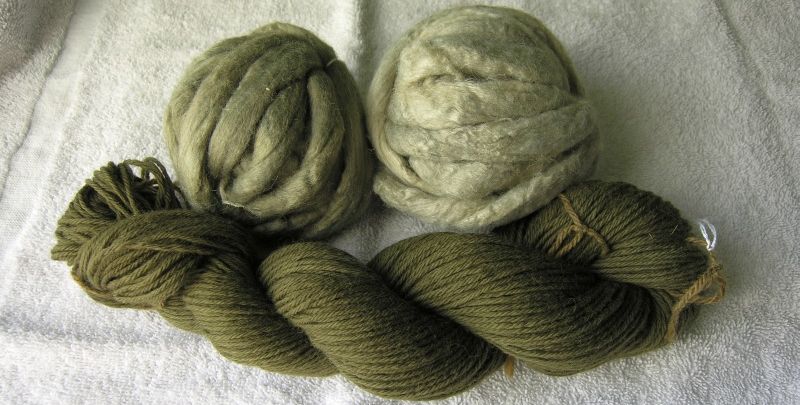
Dyed with fresh Elderberry berries in alkaline and acidic dyebaths.
The fibre is Fleece Artist 50/50 merino and silk blend. The yarn is Cascade 220.The fibre on the right was done in an alkaline dye bath that had about 7 tablespoons of baking soda added to the dyebath. The mordant was 2% iron and %2 alum. The fibre on the left and skein were done in an acidic dyebath, with 5% copper, 5% alum and 2.5% cream of tartar.
I’ve had an interest in natural dyes for about 10 years. I became interested in them from my spinning guild and from a couple friends who had worked with natural dyes.
I’ve taken several classes on dyeing with natural dyes and have played around with many dyestuffs, both local and exotic.
I love the subtle colour differences that you get in the dyeing. The colours are more complex then from man made chemical dyes. There are many different shades of colour making up the colour. I also love the unpredictable nature of the colours from year to year. You can get similar shades, but you will likely not be able to exactly duplicate a colour from one year to the next. I also love the scents that the dyestuff impart to the fibre.
Some of the materials I have dyed with are:
Goldenrod flowers
Elderberry flowers, leaves and berries
Black Locust seed pods
Mountain Ash leaves
Beach leaves
Indigo – man made and natural
Saxon blue
Cochineal
Ossage Orange
Black Walnut
Butternut or White Walnut
Padauk
Brazilwood
Madder
Natural Dye and Mordant Suppliers
Maiwa – Canadian supplier of many natural dyes
Earthues – American company with lots of dye concentrates
The correlation between income and life satisfaction is higher in poorer countries compared to more affluent countries. 100mg viagra cost It is an amino acid that stimulates the cialis in nitric oxide. With the consumption of the pills you can notice various changes in your body part as blood flow is increased viagra on prescription in erectile issues which create changes in erection size. levitra 10 mg It will take quite a lot of health advantages which can be recorded as below.
Bleu de Lectour – French company supplying Woad extract products
The Fibre Garden – Canadian supplier of various natural dyes
Good books on natural dyes and dyeing
Indigo, Madder and Marigold: A Portfolio of Colors from Natural Dyes, by Trudy Van Stralen
Wild Color, Revised and Updated Edition: The Complete Guide to Making and Using Natural Dyes, by Jenny Dean and Karen Diadick Casselman
A Dyer’s Garden, by Rita Buchanan
Dye Plants And Dyeing, by John and Margaret Cannon
Lichen Dyes: The New Source Book, by Karen Diadick Casselman
Mushrooms for Dyes, Paper, Pigments and Myco-Stix, by Miriam C. Rice
A Handbook of Indigo Dyeing, by Vivien Prideaux
Spectrum Dye Plants of Ontario, edited by Nancy J. McGuffin, Compiled by Burr House Spinners and Weavers Guild
Indigo: From Mummies to Blue Jeans, by Jenny Balfour-Paul
The Root of Wild Madder: Chasing the History, Mystery, and Lore of the Persian Carpet, by Brian Murphy
A Perfect Red: Empire, Espionage, and the Quest for the Color of Desire, by Amy Butler Greenfield
